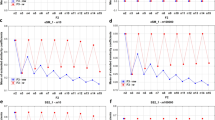Abstract
The concept of molecular dissimilarity is introduced, and shown to be a powerful complement to the well-established notion of molecular similarity. It provides a quantitative assessment of structural variation and diversity. Applications within chemical information systems are discussed. These include ranking of search output, selection of representative sets of structures, file screening, data analysis, and creativity stimulation.
Access this chapter
Tax calculation will be finalised at checkout
Purchases are for personal use only
Preview
Unable to display preview. Download preview PDF.
Similar content being viewed by others
References
Similarity and Clustering in Chemical Information Retrieval; Willett, P.; Research Studies Press: Letch worth, 1987.
Willett, P.; Winterman, V. ‘A Comparison of Some Measures for the Determination of Intermolecular Structural Similarity’. Quant. Struct. Act. Relat., 1986, 5, 18–25.
Willett, P.; Winterman, V.; Bawden, D. ‘Implementation of Nearest Neighbour Searching in an Online Chemical Structure Search System’. J. Chem. Inf. Comput. Sci. 1986, 26, 36–41.
Bawden, D. ‘Browsing and Clustering of Chemical Structures’. In Chemical Structures: The International Language of Chemistry; Warr, W.A., Ed.; Springer Verlag: Heidelberg, 1988, pp. 145–150.
Carhart, R.E.; Smith, D.H.; Venkatararghavan, R. ‘Atom Pairs as Molecular Features in Structure Activity Studies - Definition and Application’. J. Chem. Inf. Comput. Sci. 1985, 25, 64–73.
Willett, P.; Winterman, V.; Bawden, D. Implementation of Non-heirarchic Cluster Analysis Methods in Chemical Information Systems: Selection of Compounds for Biological Testing and Clustering of Substructure Search Output. J. Chem. Inf. Comput. Sci. 1986, 26, 109–118.
The Use of Lateral Thinking; de Bono, E.; Penguin: London, 1990.
Bawden, D. ‘Information Systems and the Stimulation of Creativity’. J. Inf. Sci. 1986, 12, 203–216.
Author information
Authors and Affiliations
Editor information
Editors and Affiliations
Rights and permissions
Copyright information
© 1993 Springer-Verlag Berlin Heidelberg
About this paper
Cite this paper
Bawden, D. (1993). Molecular Dissimilarity in Chemical Information Systems. In: Warr, W.A. (eds) Chemical Structures 2. Springer, Berlin, Heidelberg. https://doi.org/10.1007/978-3-642-78027-1_33
Download citation
DOI: https://doi.org/10.1007/978-3-642-78027-1_33
Publisher Name: Springer, Berlin, Heidelberg
Print ISBN: 978-3-642-78029-5
Online ISBN: 978-3-642-78027-1
eBook Packages: Springer Book Archive




